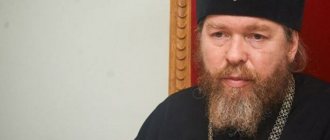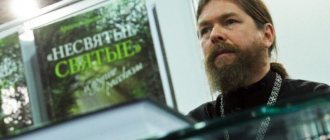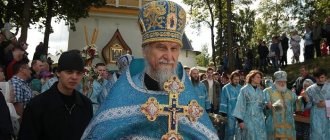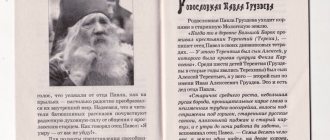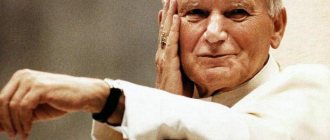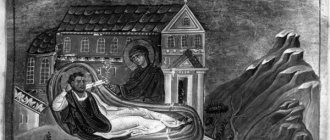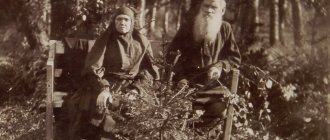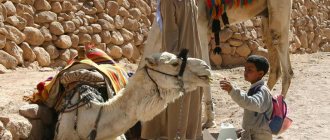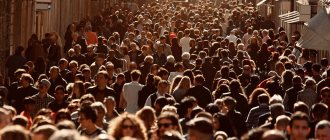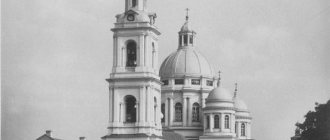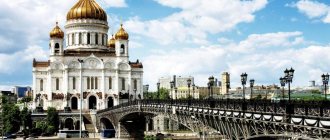| Metropolitan Tikhon (Shevkunov) |
Tikhon (Shevkunov)
(born 1958), Metropolitan of Pskov and Porkhov, head of the Pskov Metropolis, executive secretary of the Patriarchal Council for Culture of the Russian Orthodox Church, member of the Supreme Church Council of the Russian Orthodox Church, member of the presidium of the Inter-Council Presence of the Russian Orthodox Church, acting rector of the Pskov-Pechersk Theological Seminary, Holy Archimandrite and Abbot of the Assumption Pskov-Pechersky Monastery in Pechora and Holy Archimandrite of the Annunciation Nikandrovsky Monastery in the village. Lyubovets, Dubrovensky volost, Porkhov district, Pskov region In the world, Georgy Alexandrovich Shevkunov, was born on July 2, 1958 in Moscow into a family of doctors.
In 1982 he graduated from the screenwriting department of the All-Union State Institute of Cinematography with a degree in literary work.
After graduating from the institute in 1982, he received St. baptism and immediately after that he arrived at the Pskov-Pechersky Monastery, whose monks, and first of all the confessor of the monastery, Archimandrite. John (Krestyankin), had a decisive influence on his life. Novice.
Since August 1986, he worked freelance (in the status of a novice of the Pskov-Pechersk Monastery) in the Publishing Department of the Moscow Patriarchate, headed by Metropolitan Pitirim of Volokolamsk and Yuryev.
On July 2, 1991, he was tonsured a monk at the Donskoy Monastery with the name Tikhon in honor of St. Tikhon, Patriarch of Moscow and All Russia. In July of the same year he was ordained a hierodeacon, in August - a hieromonk; served in the Donskoy Monastery in Moscow.
In 1993, he was appointed rector of the Moscow metochion of the Pskov-Pechersky Monastery, into which the parish of the Vladmir Cathedral of the former Sretensky Monastery was transformed. He performed his first service in the cathedral on the feast of the Presentation of the Lord in 1994, together with the “Sretenie” brotherhood, which arbitrarily continued to occupy the cathedral.
On June 6, 1995, he was appointed abbot of the Moscow Sretensky Monastery and elevated to the rank of abbot.
| Archim. Tikhon (Shevkunov). Photo by M. Rodionov |
On September 8, 1998, he was elevated to the rank of archimandrite by Patriarch Alexy II of Moscow and All Rus' in the Moscow Sretensky Monastery.
Since 1999 - Academician of the Russian Academy of Natural Sciences.
Since March 2001, he has been the chairman of the agricultural production cooperative “Resurrection” in the Mikhailovsky district of the Ryazan region (a former ruined collective farm, being restored by the monastery).
On July 17, 2001, he was appointed rector of the Sretensky Higher Orthodox Monastic School, which was transformed into the Sretensky Theological Seminary on December 26, 2002.
Author of the film “Pskov-Pechersk Monastery”, which received the Grand Prix at the XII International Festival of Orthodox Film and Television Programs “Radonezh” (Yaroslavl) in November 2007. Author of the film “The Death of an Empire,” shown on January 30, 2008 on the Rossiya channel. Byzantine lesson."
On July 27, 2009, he became a member of the presidium of the Inter-Council Presence of the Russian Orthodox Church.
Since January 29, 2010 - member of the Commission of the Inter-Council Presence on issues of worship and church art, member of the Commission of the Inter-Council Presence on the organization of church missions (until October 23, 2014 [1]), member of the Commission of the Inter-Council Presence on issues of organizing the life of monasteries and monasticism, member commission on the organization of church social activities and charity (until December 16, 2010 [2]), member of the Inter-Council Presence commission on the information activities of the church and relations with the media (until December 16, 2010) [3].
On March 5, 2010, he was appointed executive secretary of the newly formed Patriarchal Council for Culture [4]. In the same year, he was appointed head of the Commission for Interaction of the Russian Orthodox Church with the museum community.
From December 16, 2010 to December 24, 2015 [5] - Secretary of the Commission of the Inter-Council Presence on Church Law [2].
On March 22, 2011, he became a member of the newly formed Supreme Church Council of the Russian Orthodox Church [6].
| Ep. Tikhon (Shevkunov) on the day of his consecration, October 24, 2015 |
On February 29, 2012, he was installed as abbot of the Sretensky Monastery with the presentation of the hegumen's staff in the cathedral church of the Sretensky stauropegial monastery in the city of Moscow by Patriarch Kirill of Moscow and All Rus' [7].
In 2012, he was appointed chairman of the parish council of the Churches of the Life-Giving Trinity and the Presentation of the Blessed Virgin Mary at the Saltykov Bridge in Moscow [8].
| Bishop Tikhon (Shevkunov) |
On October 22, 2015 he was elected [9], on October 23 he was named [10], and on October 24 of the same year he was consecrated Bishop of Yegoryevsk, vicar of the Moscow diocese.
The ordination in the cathedral in honor of the Kazan Icon of the Mother of God of the Kazan Ambrosian Hermitage in Shamordino was led by Patriarch Kirill of Moscow and All Rus'. Concelebrating with him were: Metropolitans of Volokolamsk Hilarion (Alfeev), Kaluga and Borovsk Clement (Kapalin), Saratov and Volsk Longin (Korchagin); Archbishops of Pesochensky and Yukhnovsky Maximilian (Lazarenko), Sergiev Posad Feognost (Guzikov); bishops of Solnechnogorsk Sergius (Chashin), Kozelsky and Lyudinovsky Nikita (Ananyev) [11]. On October 29, 2015, he was appointed manager of the Western Vicariate of Moscow.
On April 14, 2021, he was appointed rector of the Church of the Life-Giving Trinity at the Saltykov Bridge in Moscow with instructions to prepare the temple for the great consecration in 2021 in connection with the 200th anniversary [12].
On May 14, 2021, he was appointed ruling bishop of the Pskov diocese and head of the Pskov Metropolis, retaining his position as chairman of the Patriarchal Council for Culture [13].
On May 17 of the same year he was elevated to the rank of metropolitan by Patriarch Kirill of Moscow and All Rus' [14].
On May 19, 2021, he was relieved of his position as abbot of the Sretensky Monastery in Moscow and the position of rector of the Sretensky Theological Seminary [15].
On July 14, 2021, he was appointed holy archimandrite and abbot of the Assumption Pskov-Pechersky Monastery in Pechora and holy archimandrite of the Annunciation Nikandrovsky Monastery in the village. Lyubovets, Dubrovensky volost, Porkhovsky district, Pskov region.
On June 17, 2021, he was appointed acting rector of the newly formed Pskov-Pechersk Theological Seminary.
Member of the Public Council under the Ministry of Culture of the Russian Federation (since July 2012). Author of many publications in the church and secular press.
Biography
The future monk was born into a family of Soviet intelligentsia in 1958. His mother was a doctor, a respected Soviet citizen, and the family was not a believer or a church member. Georgy Shevkunov (as the future monk was called in the world) grew up as a completely ordinary Soviet child, not showing any special spiritual talents or aspirations in childhood.
Metropolitan Tikhon Shevkunov
When the time came to choose a profession, the creative young man entered the famous VGIK, the faculty of scenography. It was student age that became a turning point for the spiritual state of the young man. He began to rebel against the gray Soviet foundations, to look for something more, to think about the meaning and purpose of human life.
Graduation from university was marked by another important event in George’s life - he received Holy Baptism. Immediately after this, the young man left as a novice for the Pskov-Pechersky Monastery, where by God’s Providence he was lucky enough to become the spiritual child of the famous elder John Krestyankin.
Of course, Father John’s acquaintance and spiritual guidance played a vital role in the development of Georgy Shevkunov’s faith. A person who grew up among the Soviet intelligentsia, received a prestigious worldly education, and even in the field of culture, had to overcome a lot within himself in order to take the path of following the Lord.
Interesting! Having the necessary skills in literary work, the novice is hired to work on the publishing council of the Moscow Patriarchate. His ability to write texts and work with words came in very handy here.
Immediately the future monk met Metropolitan Pitirim (Nechaev), who impressed the young man with his selfless work for the good of the Church. And so, having gone through some path of simple novitiate and worked for the Church, in 1991 Georgy Shevkunov was honored to be tonsured a monk.
Consecration of Archimandrite Tikhon as Bishop of Yegoryevsk
This significant event took place in the Donskoy Monastery in Moscow, which had just been restored. Georgy Shevkunov was tonsured under the name Tikhon, in honor of the holy Patriarch Tikhon. Soon, the ruling patriarch ordained him to higher monastic ranks - hierodeacon, and then hieromonk. He remained to serve in the same monastery.
He gained fame in Orthodox circles in 1993, when the holy incorruptible relics of Patriarch Tikhon were found in the Donskoy Monastery. 2 years after this event, he was appointed head of the metochion of the Pskov-Pechersky Monastery in Moscow.
Since churches and monasteries were actively restored in the first years after the collapse of the Union, the issue of personnel hierarchy was acute within the Church. And in 1995, Father Tikhon was appointed abbot of the Sretensky Monastery, where he would soon be elevated to the rank of archimandrite by Patriarch Alexy II.
On the basis of the monastery, the Sretensky Theological School appeared, which already in 2002 received the status of a theological academy. Father Tikhon works here as rector. Being already a famous person, Father Tikhon also meets the head of state, Vladimir Vladimirovich Putin.
Metropolitan Tikhon with Vladimir Putin and Patriarch Kirill
The archimandrite accompanies the president on his trip to the Pskov-Pechersky Monastery, and later during his visit to the USA. Ill-wishers shrouded this trip in a lot of gossip and rumors; Father Tikhon began to be called an agent of the president. Nevertheless, the archimandrite continued his work for the good of the Church.
In 2004, the future bishop graduated from Sretensky Theological Seminary as an external student, having officially received a document on theological education.
Actively participates in the movement to reunite the unity of the Russian Orthodox Church of the Moscow Patriarchate and the Orthodox Church of the West. It is through his works that today we have unity with many of our brothers in faith living abroad.
Important! In 2012, in the main church of the Sretensky Monastery, at a majestic bishop's service, Patriarch Kirill solemnly proclaimed Father Tikhon as abbot of the monastery and presented him with a special abbot's staff.
Father Tikhon is actively involved in many issues of internal church life. So, he becomes the secretary of the cultural council under the Patriarch, and is also a member of the supreme church council of the Russian Orthodox Church.
Awards
Church:
- Order of St. Sergius of Radonezh II Art. (2008)
- Order of St. equal to book Vladimir III Art. (2008, “in consideration of the work in restoring unity with the Russian Church Abroad”)
- Order of St. Nestor the Chronicler (2010, UOC)
- Order of St. blgv. book Daniel of Moscow I Art. (2017)
- Order of St. Sergius of Radonezh III Art. (2019)
Secular:
- national award named after P.A. Stolypin “Agrarian Elite of Russia” (2003, in the nomination “Effective Land Owner” and a special sign “For the Spiritual Revival of the Village”)
- award “Best Books and Publishing Houses of the Year” (2006, “for publishing religious literature”)
- Order of Friendship (2007, “for merits in the preservation of spiritual and cultural traditions, great contribution to the development of agriculture”)
- Award “Best Book of the Year 2007” (2008)
- Izvestia newspaper award (2008, Izvestia)
- laureate of the national award “Person of the Year” for 2008 and 2009
Formation of the bishopric
Continuing his service for the benefit of the Russian Orthodox Church, Father Tikhon in 2015 at the Optina Pustyn monastery was named Bishop of Yegoryevsk. Patriarch Kirill elevated him to the rank. Father Tikhon combines this position with the title of patriarchal vicar.
A year later, Bishop Tikhon was appointed rector of the Church of the Life-Giving Trinity in Moscow, near the Saltykov Bridge.
Bishop Tikhon’s rapid career in the church hierarchy gave rise to rumors that he is the mentor and successor of the current Patriarch Kirill. This topic has been repeatedly discussed in the media, and, in particular, on the Ekho Moskvy radio station.
Father Tikhon at a service in the Holy Trinity Cathedral in Pskov
Father Tikhon himself did not confirm such rumors in any way, citing the fact that only a bishop who has independently governed an entire diocese for many years (at least 5) can be elected patriarch. Father Tikhon is a patriarchal vicar, so he was not fully involved in the management of the diocese entrusted to him.
Since 2021, Bishop Tikhon has been the ruling bishop in the Pskov diocese. In the same year, he was removed from the post of rector and abbot of the Sretensky Monastery, where he was replaced by clergy from the monastery itself. In parting, Father Tikhon served the last solemn Liturgy, where he said goodbye to his Moscow flock, after which he left for Pskov.
Since the summer of 2021, he has been holding the position of abbot of the Pskov-Pechersky Monastery.
Archimandrite Tikhon (Shevkunov): “The life of a Christian is the highest creativity in the world”
“Invented stories are not interesting”
| Archimandrite Tikhon (Shevkunov) |
— Father Tikhon, I once had the opportunity to meet a famous composer, the father of your classmate at VGIK.
Having seen your interview in our magazine, he said: “I once knew Father Tikhon in his student years. He was a very interesting, lively person. But the question is: did he not bury his talent in the ground, choosing, in his opinion, a higher path? religion? Did this question worry you when you were planning to become a monk? — You know, by that time I realized that the life of a priest, a monk, a Christian (after all, a monk is a Christian, first of all) is the most real, the highest creativity in the world available to man. The artist decorates the canvas and brings it as a gift to people. A composer creates a piece of music. And a Christian tries to cleanse, transform his soul and bring it to God. This is the most amazing, most interesting creativity that exists on earth. Therefore, it seems to me that all Christians are amazingly creative people.
“When you meet a person of high spiritual life, you warm up in his presence. And, on the one hand, I want to literally stop the moment, somehow capture it, preserve it. On the other hand, you understand that this is practically impossible. The film about the elders of the Pskov-Pechersky Monastery is a rare case when, it seems to me, this was achieved.
| Metropolitan Pitirim (Nechaev) at work |
- You are absolutely right: indeed, you want to grasp and preserve this impression, state, that memory of a person that is gradually slipping away.
When I was transferred to Moscow from the Pskov-Pechersky Monastery, the most painful and offensive thing for me seemed to be that I would no longer see these great spiritual people - the elders, about whom I later made an amateur film. I found myself with a video camera in my hands, which was a rarity back then, in 1986. Metropolitan Pitirim [1], for whom I was working at that time, gave it to me. And I realized for myself that the first thing that needs to be photographed and captured is, of course, the elders of the Pskov-Pechersk monastery. Then, much later, I collected all these scattered materials into a rather long one and a half hour film. It was twice as long as what the audience later saw. I showed it to my friends, and at the Sunday school of the Sretensky Monastery, and at our seminary. We even had such a tradition, even before this film became widely known - the brethren of the monastery watched it before Lent, on Forgiveness Sunday. And it softened hearts so much, prepared them for fasting, and inspired them that they watched it on Forgiveness Sunday for many years. It is a great happiness for me that I was able to capture these people - the elders, schema-nun Margarita, whose conversations formed the basis of the film “Mother Frosya’s Stories about the Diveyevo Monastery.” These are truly amazing people; they lived through a unique time in the history of Christianity - the 20th century. There are no such people anymore and there never will be.
— Why is the film, which was released in wide release, only 40 minutes long?
— This was required by the television format when the film was being prepared for showing on RTR. I don't think he suffered much from the layoff. Although some interesting things were left behind the scenes, the main, most important things were included in a concentrated form in the 40-minute film.
— Why is the documentary film genre interesting to you? An opportunity to preserve the past, to draw some parallels with the present? And are you planning to shoot anything else?
— Fiction in literature, invented plots in feature films are not very interesting to me. The most amazing, the most beautiful thing in life is life itself.
As for cinema, for me this kind of craft is not a business, but a craft, because the most important thing for me is priestly service and the fulfillment of my church obedience. We have a large monastery, a seminary, a publishing house, an orphanage with a hundred children, an Internet site and many other concerns and matters, very interesting and important. However, we recently completed a lot of work within the framework of the church-public council for protection against the threat of alcohol, which was formed two years ago. We made ten films and forty social advertising videos, which are shown on central television and, most importantly, in the regions. This project, of course, was carried out by a whole group of people, but believe me, ten full-length documentaries is a lot of work.
And I'm still finishing the book. This is what warms me now and takes up all the time that can conventionally be called free. About twenty stories have already been prepared, and there will be maybe fifty in total. Some of them have already been published on the Pravoslavie.ru website...
- ... and caused a great response from readers. It turns out that the entire book has not yet been written?
“It’s ready in my head.” And in order to write each story, you need time, which is practically non-existent. And all this is written, mostly, only on the road, on my knees.
Monastery in the center of the metropolis
— Sretensky Monastery was initially revived as a metochion of the Pskov-Pechersky Monastery. How did the Pechersk elders see this monastery in the center of Moscow? Did they give advice on its construction?
| Archimandrite John (Peasant) |
— Of course, first of all, Father John (Krestyankin) [2], who blessed the creation of the Moscow metochion, gave us his instructions.
I was recently in Pechory, went to his grave for one day. Then Archimandrite Tavrion, the current monastery confessor, and I stood together in the church at a service, and during kathisma he suddenly said: “Listen, do you remember what the tribute is today?” - "Which?" - “Iveron Icon of the Mother of God. In 1993, Father John blessed the creation of the Pskov-Pechersky Monastery’s courtyard on this very day.” And from this significant coincidence, from these words, I felt very warm and joyful. Indeed, it was seventeen years ago that Father John, completely unexpectedly for me, and for everyone, suddenly said: “You will create a courtyard of the Pskov-Pechersk Monastery in Moscow. Do not be afraid of anything!". When the monastery began to grow, Father John gave his blessing to create a monastery, which would still remain connected with the Pskov-Pechersky Monastery. The brethren from Pechory stay with us here, and we often go there, and as before, the Pskov-Pechersky Monastery, its liturgical traditions, and the spiritual precepts of its elders largely determine our lives. Father John wrote a lot about the structure of monastic life, followed, especially in the early years, how the monastery was developing, followed the difficult situation that unfolded around the metochion in connection with the well-known events of 1994–1995 in the church life of the city of Moscow[3 ]. And for us, his attention, of course, was simply priceless. Father John did not tell us anything fundamentally different from what is written in his letters about monasticism. But these were his innermost thoughts, the hard-won and experience-tested ways of organizing monastic life.
— The life of a monastery in the very center of a metropolis is probably very different from the life of a more traditional monastery. Can we say that it is more complicated?
— Of course, it is much more complicated, although “complicated” here is not quite the correct concept. The monastery is located not just in the center of Moscow, but at the epicenter. On the other hand, by and large, the life of the inhabitants of the Trinity-Sergius Lavra is probably no less difficult - there are an incredible number of not even pilgrims, but tourists, while we still have many times fewer of them. The Alexander Nevsky Lavra in St. Petersburg, the Moscow Danilov and Novo-Spassky monasteries are in approximately the same position. And many monasteries in Russia are now located in the city center. But this is God’s Providence, otherwise we don’t perceive it: hence the preaching mission of monasteries, and the spiritual, liturgical mission, because a monastery is a place where people can participate in liturgical life and find spiritual guidance. The main task of the confessor is, together with the person who came to him, to seek the will of God in relation to this or that life situation, in solving the spiritual problems facing a person.
A modern monastery in a city or village is obliged to carry out a Christian educational mission. And it is closely connected with the path of personal salvation that every resident goes through here - just as the path of salvation of a priest, confessor is inextricably linked with those people who come to him: Behold, I and the children whom God gave me
(Isa.
8,
18).
“And yet, initially the meaning of monasticism is removal from the world, and any “external activity” is associated with inevitable difficulties for a monk. What helps the inhabitants of the Sretensky Monastery maintain their internal order?
— Yes, every monk has a need for solitude, internal and external. If from the very beginning someone had told me that, having escaped from the capital, having come to the monastery, I would again find myself not just in Moscow, but in its center, I would probably have been horrified. I think in the same way, everyone who dreams of monasticism does not even imagine where they will have to end up over time and what obediences they will have to carry out. But the Lord very mercifully leads us in His ways to what we need to do.
We, of course, try to somehow maintain inner solitude - this is a necessary part of spiritual life. Most residents of city monasteries, not only ours, try to live concentrated lives. We have monks who do not leave the monastery at all - they live and know only the cell and the temple.
| Distribution of holy Epiphany water. Photo: Anton Pospelov / Pravoslavie.Ru |
We have several rules we have developed that are strictly followed.
For example, in addition to the fact that we serve every day, on Thursdays we have a fraternal service: all the brethren receive communion - priests, monks, and novices. Many monastics live a very rich liturgical life and receive communion, on average, four times a week. This is very important - both the preparation for Communion itself and Holy Communion itself. It is impossible even to overestimate this part of spiritual life. We often have night services, at which, as a rule, only monks pray and receive communion. We even asked His Holiness the Patriarch for his blessing to build several house churches inside the fraternal buildings so that three or four people from the brethren could perform the Liturgy at night and receive communion in complete solitude. Maybe for monasteries that are located far from cities, this is not so important, but for us it is truly vital. — There are a lot of churches in Moscow, and each church has a parish that has its own personality. I have heard from Muscovites that the parish of the Sretensky Monastery is a “male parish.” Do you have this feeling?
“We really have a lot of men.” I don’t know why, maybe because it’s a male monastery? There are practically no residential buildings around us, mostly government institutions, so people come to us from all over Moscow. Our people know the church rules well and love them: they don’t talk during services, men stand on the right, women on the left. Apparently, this entire cohort of young people and mature men who stand seriously and pray makes such an impression. We have a lot of young people: I think that more than half of our parishioners are people under 45 years old. I remember when we had our first grandmothers, it was a big deal! We simply trembled over them, we didn’t know how to please them - it was such a great joy for us.
“Apparently, this became a kind of confirmation of the traditional nature, the closeness of the temple to the Moscow tradition.
| Cancer with the relics of the Hieromartyr Hilarion (Trinity). Photo: Victor Kornyushin / Pravoslavie.Ru |
- Of course, this was a kind of recognition.
Our oldest parishioner was the spiritual daughter of the Hieromartyr Hilarion [4], she was 100 years old when she died, we buried her. And now, although less often, Evgenia Matveevna, she is 98 years old, comes to church. That's how a grandmother is - she walks around with two bags, in each bag there is a brick, on the right and on the left, she throws the bags over her neck on some kind of scarf. I say: “Why do you need bricks?” She says: “And so that I don’t sway, this is for my balance.” She comes to services from Belyaev, this is the very outskirts of Moscow. In general, our parishioners are wonderful, we love them very, very much. Some, however, complain: “You won’t be crowded.” Yes, unfortunately, we have a very small church, and there are so many people, especially on holidays and Sundays, that even though we have added a gallery to the church, many still have to pray on the street. Our dream is to build a new big temple, but so far there are many problems with this.
“Our time does not give reasons for inspiration”
— You mentioned the “Common Cause” project. It is clear that to form public opinion it is necessary to use modern media, and in order to reach the modern person, who is quite impenetrable and accustomed to everything, it is necessary to find an extraordinary creative move. What was supposed to be the “pain point” for the viewer?
— The most natural reaction of the viewer is to be horrified by the degradation, the abyss into which we are sliding. We are not going to devote our lives to the fight against drinks - we are confronting a real existing problem. The goal of the “Common Cause” project and the work of the church-public council for protection against the threat of alcohol is to influence the younger generation so that they do not obediently go into that terrible abyss in which 700 thousand of our fellow citizens die every year. The consequences of alcohol abuse are popular lack of will, degradation (let's call a spade a spade), loss of that high passion that has always been inherent in the Russian people, indifference. The loss of a clergyman, the loss of culture—the loss of everything.
(FLV file. Duration 2 min. Size 4 Mb)
Nobody talks about the need for total sobriety, it is unrealistic and ridiculous, forgive me our teetotaler colleagues who advocate an absolute abstinence from alcohol. In Russia, wine has always been a means of helping in communication, creating a kind of community. For example, I can sometimes drink a little wine. We simply encourage people to be responsible. The criterion here is this: if a person can sit with friends, share a meal and then stops, does not become a problem either for his neighbors, or for himself, or for saving his own soul (and this is the main thing) - then this is a responsible, normal attitude. If a person, having drunk, becomes a grief and a terrible misfortune for those closest to him, if a glass becomes an obstacle to his salvation, then in this case the responsible attitude will be a complete abstinence from alcohol.
— In recent years, many contradictory events have taken place in church-public relations and in the cultural sphere, for example, art exhibitions took place, the content of which was considered blasphemous by believers. Their discussion was so harsh in tone that a persistent stereotype emerged: the Church is an opponent of modern art. How do you, Secretary of the Patriarchal Council for Culture, feel about contemporary art?
— I don’t really understand what contemporary art is. I don't understand what this is. Moreover, the more I think about it, the more I realize that I fundamentally do not want to understand this! There is art - and there is not art. What is not art simply is not art, and there is no point in discussing it. No matter how someone convinces that this is art, no matter what labels of modernity they attach. What is most often now called modern masterpieces are crafts that are beneficial to someone to call art for one reason or another, and often these reasons are very bad.
— What do you like to read and watch?
“I am truly interested in church art when it is subtle, noble and lofty.” Unfortunately, among the works of fiction, painting, and music, I have not come across anything comparable to at least the outstanding examples of real art created during the Soviet period.
— Is this a global process or is it typical for our country?
— This is partly a global process, but we are more interested in our country. Maybe our time is like this - it does not provide reasons for inspiration, the creation of high examples of art? There are interesting attempts, but I want something more.
— The last question is a little personal. What would you like to change in your life and what are you especially grateful to God for?
“The longer you live, the more you understand the words of St. John Chrysostom: “Glory to God for everything!” And although we cannot repeat this as he would say - with all our souls, with all our hearts, with all our lives - but, in any case, we understand more and more that nothing is accidental, nothing is in vain, except sin, in life No. And the Lord transforms our sins, our weaknesses into salvation for us. If you extract the precious from the worthless, you will be like My mouth,
as one prophet said (Jer. 15, 19).
I don't want to change anything. As the Lord leads, so be the glory of God! And this is not, you know, weak-willed fatalism, this is really conviction. Living in the world is joyful and interesting. Especially for an Orthodox person, because he understands many things more deeply and more is revealed to him. Life itself next to Christ, when we try to be real Christians, with more or less success, when we try to fulfill our duty, our calling with all our might, is the highest happiness.
